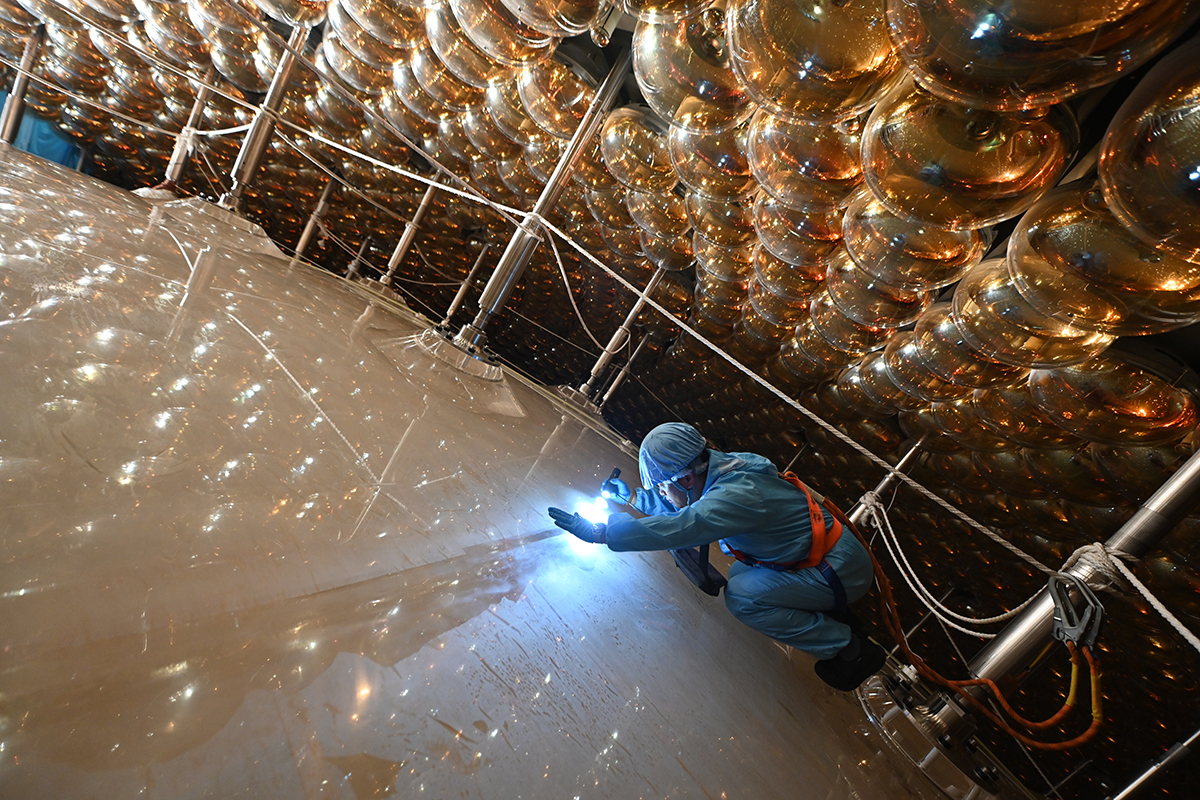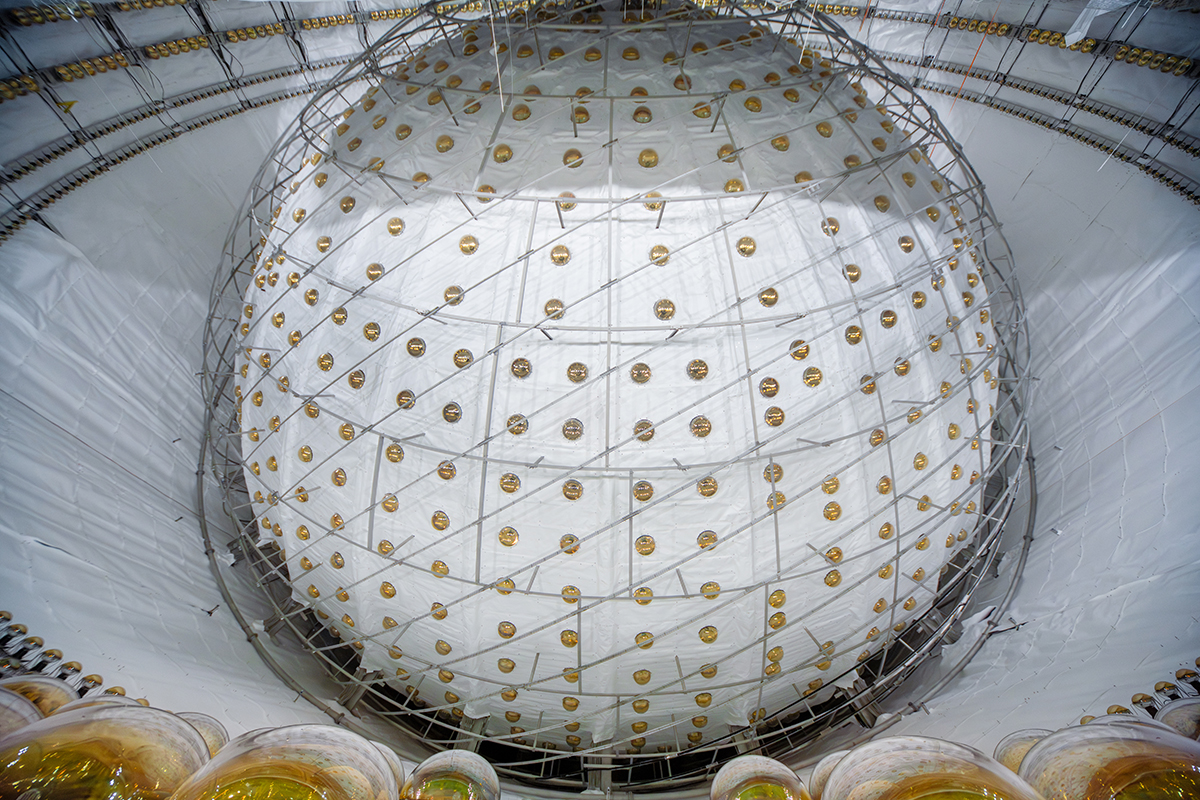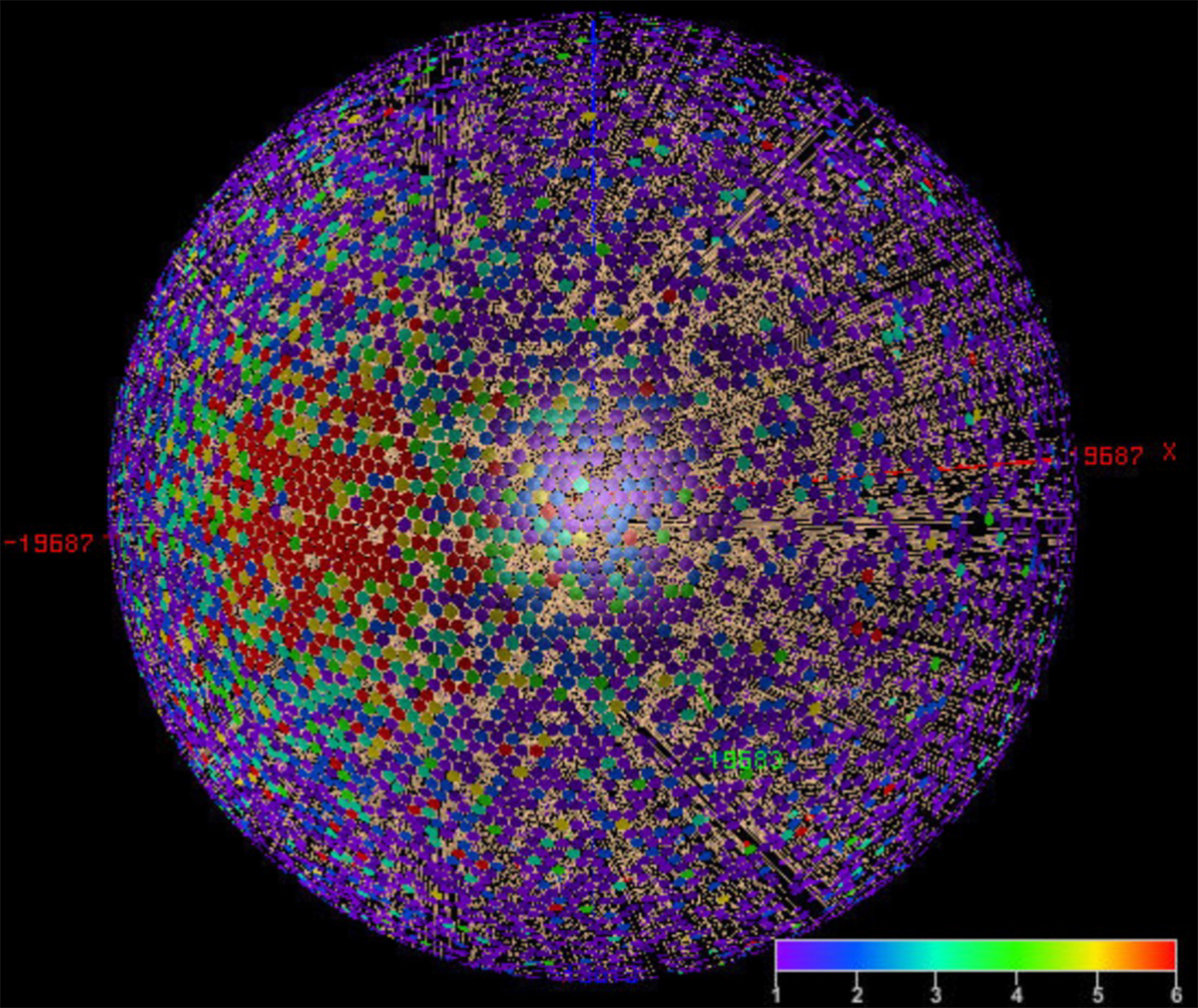Next-generation underground neutrino detector in China up and running

A worker peers into JUNO’s central detector, a hollow sphere filled with 20 000 tons of liquid scintillator.
(Photo by Yuexiang Liu, IHEP.)

The Jiangmen Underground Neutrino Observatory (JUNO) achieved a major milestone in August, after 10 years of construction, when it began collecting data. More than 700 scientists from 17 countries are contributing to the facility, which is the largest liquid-scintillator detector in the world. Its primary goal is to determine the ordering of the neutrino masses.
Located 700 meters underground near China’s south coast, JUNO measures electron antineutrinos arriving from two nuclear power plants, each about 50 kilometers from the detector. JUNO uses similar technology to China’s Daya Bay Reactor Neutrino Experiment, which ran from 2011 to 2020, but the new, roughly $350 million facility operates on a much larger scale, says J. Pedro Ochoa-Ricoux, a professor of physics and astronomy at the University of California, Irvine, and a member of the JUNO experiment.
JUNO is the first of the three new large neutrino detectors under construction around the world to begin operations. Japan’s new detector, Hyper-Kamiokande (Hyper-K), is slated to begin in 2028. The US’s Deep Underground Neutrino Experiment (DUNE) is not scheduled to launch until at least the late 2020s. (See Physics Today’s 2018 story “Japan’s next neutrino detector to have huge tanks, bright beam
Like JUNO, Hyper-K and DUNE are designed to determine the neutrino mass ordering, also known as the neutrino mass hierarchy, and other neutrino characteristics. The JUNO team feels pressure to be the first with mass-ordering results, says physicist Yifang Wang, who is leading the JUNO experiment at China’s Institute of High Energy Physics (IHEP). About 45 reactor antineutrinos will be observed per day in the detector. “After about six years of data collection, we should be able to determine the mass hierarchy up to the level of three sigma,” Wang says.
Kam-Biu Luk, a coleader of the Daya Bay experiment, says the new detectors are the natural next step for the field. “After Daya Bay conclusively showed that θ13 is nonzero, a new generation of neutrino-oscillation experiments were initiated for tackling the remaining questions which are central for completing our understanding of neutrino mixing,” says Luk, a physics professor at the Hong Kong University of Science and Technology and the University of California, Berkeley. The angle θ13 is one of the three parameters describing the superposition or mixing of neutrino mass states that’s at the heart of neutrino oscillations from one flavor to another. (See Physics Today’s 2012 story “Reactor experiment reveals neutrino oscillation’s third mixing angle
Getting the mass in order
Determining the neutrino mass ordering is central to updating the standard model of particle physics. The model does not account for nonzero neutrino mass, and resolving the mass ordering will be key to developing a theoretical understanding of the origin of lepton masses and mixings. The mass ordering has implications for, among other things, cosmology and our understanding of the evolution of the universe’s large-scale structure.
The three neutrino flavor eigenstates—electron, muon, and tau—are quantum superpositions of different neutrino mass eigenstates. The relative sizes of the three neutrino masses m1, m2, and m3 is the mass-ordering question. Masses m1 and m2 are the closest in size, with m1 the smaller of the two. Mass m3 could obey normal ordering, given by m1 < m2 < m3. Alternatively, neutrinos could obey inverted ordering, with m3 < m1 < m2.
The previous generation of neutrino experiments, Japan’s Super-Kamiokande detector and the US-based NOνA (NuMI Off-axis νe Appearance), has tried to determine the ordering, but the signals are subtle, says Duke University physics professor Kate Scholberg, a member of DUNE. The determination hinges on teasing out distortions in the oscillation pattern of electron and muon neutrinos. The current generation of detectors hasn’t come up with a definitive answer yet, so it’s up to the next generation of very large detectors to find it, she says.
JUNO’s detector measures antineutrino interactions with protons, called inverse beta-decay reactions. It precisely measures the two components in the energy spectrum that are caused by oscillations. The low-frequency component of the energy spectrum comes from the oscillation of the neutrino mixing angle θ12 and the mass-squared difference . The high-frequency component is controlled by the oscillation resulting from θ13 and .
The team can fit the experimental data to the equation for the survival probability of reactor antineutrinos. That will help the researchers determine the four parameters and the ordering of the neutrino masses, which is indicated by the sign of the remaining mass-squared difference, . The sign of will be positive if mass ordering is normal or negative if it is inverted.

JUNO’s central spherical detector is seen here from the outside before the surrounding chamber was filled with ultrapure water. Neutrino signals are generated by the liquid scintillator inside the sphere. The outer chamber of water shields the inner detector from natural radioactivity, and the white Tyvek film stops light generated from reactions in the water from entering the sphere. A thin metal lattice covers the outside of the central sphere to shield its photomultiplier tubes from Earth’s magnetic field.
(Photo by Yuexiang Liu, IHEP.)

“Mass ordering is the gateway for the ultimate question,” says Sam Zeller, deputy project director of the DUNE detector at Fermilab. It will allow scientists to determine the extent to which neutrinos violate CP (the combination of charge conjugation and parity) symmetry, which has implications for the matter–antimatter imbalance in the universe (see the 2020 Physics Today story “Accelerator experiments are closing in on neutrino CP violation
A knife’s edge
Reactor antineutrinos have much lower energies than accelerator neutrinos: They are in the megaelectron-volt range rather than at accelerator neutrinos’ gigaelectron-volt levels. “It’s a very low-energy regime. There’s a lot of radiological background,” says Scholberg. The JUNO team, she says, “is drawing on a lot of past experience, but it’s definitely a hard thing to do.” But JUNO’s approach has benefits too. Inverse beta-decay interactions are more well understood than higher-energy neutrino interactions and will give JUNO a cleaner reading of the energy spectrum.
The experiment will have to collect data with an energy resolution of at least 3% at 1 MeV, with an energy uncertainty lower than 1%. “There’s not a lot of room for mistakes,” says Ochoa-Ricoux.
JUNO’s central detector is a 35.4-meter-diameter acrylic sphere filled with 20 000 tons of liquid scintillator. It is 20 times as massive as the world’s next-largest liquid-scintillator detector, Japan’s Kamioka Liquid Scintillator Anti-Neutrino Detector experiment, better known as KamLAND. JUNO’s liquid scintillator is exceptionally clear; it has a light attenuation length of 20 meters, which is an 8-meter improvement over Daya Bay’s attenuation length, Wang says.
More than three-quarters of the sphere’s surface is covered in approximately 43 000 photomultiplier tubes. The PMTs capture the scintillation light from the inverse beta-decay reactions. Existing PMTs at the time of JUNO’s planning phase were not sensitive enough to detect the small number of photons produced by the liquid scintillator, so the researchers made their own, says Wang. By changing the PMTs’ electron amplification stages and improving their photocathode’s quantum efficiency, the JUNO team increased their PMT photon-detection efficiency to double that of Super-Kamiokande’s PMTs.
JUNO’s central detector is suspended in a 44-meter-deep cylindrical water Cherenkov detector to shield it from cosmic rays and Earth’s natural radioactivity. About 2400 additional PMTs point into the water Cherenkov detector to veto incoming cosmic rays. Those measures filter out background events to get a clean neutrino signal and improve the detector’s energy resolution.
The project faced major engineering challenges, says Wang. Unlike the horizontal tunnel built for Hyper-K, he says, engineers had to dig a sloped tunnel going down into the mountain. “Building a detector with a 40-meter diameter underground with very limited space for people to work was hard because you just don’t know where people can stand.”
Friendly competition
DUNE and Hyper-K could independently determine mass ordering using different approaches than JUNO. Both are long-baseline accelerator experiments that examine the oscillation of muon neutrinos to electron neutrinos (and muon antineutrinos to electron antineutrinos).
DUNE will send a flow of neutrinos produced in Fermilab’s Long-Baseline Neutrino Facility to a liquid-argon time-projection detector at the Sanford Underground Research Facility in South Dakota 1300 kilometers away. The experiment will use those accelerator neutrinos to determine the mass ordering.
Hyper-K will use a 71-meter-deep water Cherenkov detector in Kamioka to measure neutrinos from the Tokai-based Japan Proton Accelerator Research Complex (J-PARC) accelerator 295 kilometers away. The experiment will make use of atmospheric and accelerator neutrinos for the mass-ordering determination.

A neutrino detected by JUNO on 24 August, as recorded by the experiment’s approximately 43 000 photomultiplier tubes.
(Image from the JUNO Collaboration.)

Once operational, DUNE would need only a few months of data to determine the mass ordering, says Zeller. She says it is the only experiment, either planned or current, that can measure the mass ordering at five sigma, the accepted threshold to be considered a discovery-level measurement. “From this regard, JUNO has to be faster, quicker. Otherwise, results will be quickly overwritten by DUNE,” says Wang.
“JUNO will be really very complementary to the measurement that will happen with the long-baseline experiments,” says Scholberg. For instance, the oscillations that JUNO observes are insensitive to neutrinos’ interactions with matter and to the phase factor describing CP violation; accelerator experiments must take both into account.
“If our theories are correct, the experiments should, of course, get the same answer,” says Zeller. “Determining neutrino mass ordering in completely different ways will be super interesting to see.”
Other applications
JUNO’s operating timeline is 30 years. Wang says that after the experimental team determines the mass ordering, it plans on broadening its focus to research in astrophysics, cosmology, and geophysics.
“JUNO is going to be a major player in understanding supernovae through the detection of neutrinos,” says Erin O’Sullivan, an associate professor of physics and astronomy at Uppsala University. JUNO could detect neutrinos that nearby supernovae emit even before they collapse; those neutrinos would provide early notice that an even larger burst of neutrinos is headed toward Earth imminently. The notice would give detector teams the opportunity to cancel any planned downtime and alert electromagnetic telescope operators.
William McDonough, a member of JUNO and an Earth sciences professor at Tohoku University and the University of Maryland, is looking forward to JUNO’s geoneutrino measurements. (See the 2012 Physics Today article “The many uses of electron antineutrinos
Wang says the long-term plan is to upgrade JUNO to become a detector for neutrinoless double-beta decay by loading candidate isotopes into its liquid scintillator. Searching for neutrinoless double-beta decay would help determine whether neutrinos are Majorana particles—that is, their own antiparticles—one of the highest-priority questions in particle physics. But the isotopes are radioactive and will lower the transparency of the liquid scintillator.
“We have to wait until the mass hierarchy has been determined or DUNE is on line and we are not able to compete anymore,” says Wang. “Then we’ll say, Let’s forget about that, let’s go do double-beta decay.”
